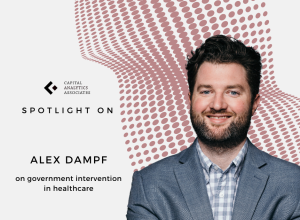 3 min read February 2024 — Invest: spoke with Alex Dampf, founder and president of Oakmont Benefits Group, about what makes the firm “nontraditional” in its sector, the impact of rising healthcare costs, and the effect of an increase in demand for healthcare services. “Many people aren’t getting preventive care, and we are seeing more and more urgent care facility & ER visits with astronomical prices. We need to focus on prevention so we can avoid that,” he added.
3 min read February 2024 — Invest: spoke with Alex Dampf, founder and president of Oakmont Benefits Group, about what makes the firm “nontraditional” in its sector, the impact of rising healthcare costs, and the effect of an increase in demand for healthcare services. “Many people aren’t getting preventive care, and we are seeing more and more urgent care facility & ER visits with astronomical prices. We need to focus on prevention so we can avoid that,” he added.
Where are the biggest opportunities in the healthcare sector right now?
Many people believe that there needs to be some sort of government intervention in healthcare pricing. I am all for a capitalist society and free market, but healthcare isn’t truly a free market because there is some government intervention. Looking to the future, we can work collaboratively between healthcare providers, healthtech companies, and individuals as one movement. We can avoid the need for the government or insurance companies to facilitate those relationships.
What strategies help you to maintain a standard of excellence as a company?
This is a big focus for us because at our core we are trying to be disruptive in our sector. We have tried many strategies in working with new companies in our space, where we are dealing with companies that don’t have a lot of historical knowledge of the healthcare delivery system. When we build a health plan for an employee, we need them to understand it, or it could make the situation worse. It is our job to gauge how the end user understands the process, or the limitations that are being put on them. If we can’t do that, we are failing at our initiatives.
How have recent changes in the market impacted your organization, if at all?
We haven’t been directly impacted at Oakmont, but we see the impacts in the environments that we work in. There has been a big push with organizations like Patient Rights Advocate about pricing and quality transparency. If we could have some type of government support to access those programs, so we can leverage that information, it would be very helpful. The flipside of that is that the economy is constricting some and healthcare prices are going up. There is a lot of pent-up demand, which is also impacting prices. People also put off treatment during COVID and that has made the problem more expensive. Many people were forced into a box during COVID, and they avoided taking care of their ailment because of restrictions or other factors. That has put a strain on the healthcare system because we are experiencing labor shortages and other economic constraints. We need more care but have fewer people providing it. All this is creating a death-spiral at the end of the day. Many people aren’t getting preventive care, and we are seeing more and more urgent care facility & ER visits with astronomical prices. We need to focus on prevention so we can avoid that.
How are you making healthcare more cost effective? How are you bridging the gap between healthcare and insurance?
Insurance companies will never make the cost of healthcare go down. It is counterintuitive to their business model and practices. The burden is on those who must pay and provide healthcare to their employees. It is important for employers to work with local organizations to have direct relationships with consumers. It is our core business model to bridge the gap between employers and healthcare delivery systems. There are many new government regulations around the ability to access quality cost data, and people are finding there are many costs in that equation that are applied by third parties that don’t add any quality to that care. It basically comes down to a line-item level of whether things make sense for an employee, so everything is being re-evaluated.
We are also closely watching the transparency rules and increase in regulations for our clients. Some of the new laws are close to impossible to comply with, so we must show our clients how to navigate these rules. Managing compliance is one of our biggest challenges moving into the future.
Another factor is that telehealth is the wave of the future, but how it is delivered today is far from perfect. Employees and patients want continuity of care. They want the same doctor every time. We can reduce costs by eliminating large buildings and parking lots, and by having more decentralized local hubs, so we can better move people to exactly where they need to go. That can help reduce costs, and that is one of our main goals.
What is your outlook for Oakmont Benefits Group over the next two to three years, and what will be your top priorities?
We will continue to grow, and we will find more businesses that are receptive to the models we produce. We are a little bit more upstream compared to other healthcare companies, but with exploding costs, we are seeing increased interest in our services. Our top priority is to continue to understand how we can better partner with healthcare delivery and the providers and services directly. There will always be a level of friction, but we can find a middle ground between profit and quality care.
For more information, visit:
